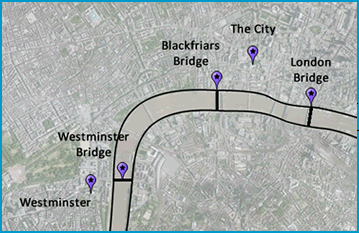Bridges in London
Until the mid eighteenth century, the Thames could be crossed by one bridge only (“London Bridge”); this is due partly to the hostility of the City authorities, which did not wish the traffic to be diverted towards other parts of the metropolis, and also to the opposition of the guild of watermen, who feared losing their customers.
The capital had anyway mostly developed on the North bank of the river; few people lived on the South bank, which mostly accommodated dockyards, breweries, sawmills, tanneries and other factories.
Westminster Bridge was built in the forties, then Blackfriars Bridge in the latter part of the century.
London Bridge
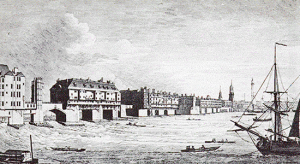
- Old London Bridge
- Anonymous view of Old London Bridge (engraving, 1746, detail)
[click on the picture to enlarge it]
Before1750, Londoners could only use one bridge, the very old “London Bridge” connecting the City to the Southwark suburb. It was a stone bridge dating back to the twelfth century, which was repeatedly restored till it was replaced in 1831.
Until 1762, it was lined with three-storey houses including shops, thus retaining its old-fashioned appearance.
With its narrow low arches, it was a serious hindrance to navigation; its central part was consequently adapted at that time to allow bigger ships through.
London Bridge was also painted by Samuel Scott and by William Marlow. It appears in the final City scene of Hogarth’s Marriage a la Mode
Westminster Bridge
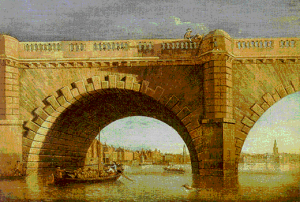
- Westminster Bridge
- Samuel Scott View through an Arch of Westminster Bridge
(oil on canvas, c. 1755), an example of a framing effect imitated from a Canaletto.
(c) Tate Gallery, London, 2000
[click on the picture to enlarge it]
In 1750, Westminster Bridge was opened . Plans for it, which had been put forward long before, could only be carried through thanks to a tenacious committee of local residents and MPs, Parliament being close by. It was mostly financed by a lottery, which also provided compensations for the watermen. It was designed as a modern-looking stone bridge by a Swiss-born architect, Charles Labelye. For the first time in England the “caisson” technique was used to erect its foundations. But it took ten years before it was opened to the traffic, one of the piers having collapsed in the process of construction. It favoured the development of the Lambeth district on the South bank. The Venetian painter Canaletto and his English follower Samuel Scott have left several views of it.
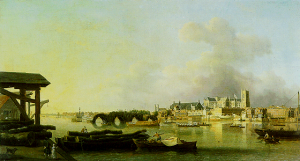
- Westminster Bridge
- Samuel Scott, Westminster Bridge
(1748-49, The Governors and Company of the Bank of England)
[click on the picture to enlarge it]
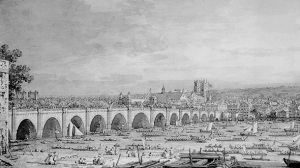
- Westminster Bridge
- Canaletto, Westminster Bridge
pen, ink and wash (1746-47)
(The Royal Collection (c) 2000 Her Majesty Queen Elizabeth II)
[click on the picture to enlarge it]
Samuel Scott also painted a view of Covent Garden.
Canaletto also made views of the bridge under an arch.
Blackfriars Bridge
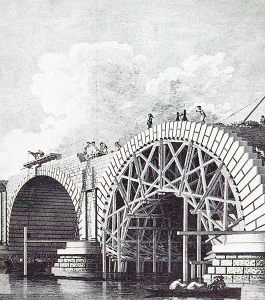
- Blackfriars Bridge
- Piranesi, View of Blackfriars Bridge under construction (engraving, 1766)
[click on the picture to enlarge it]
The last bridge opened in the 18th century was Blackfriars Bridge, named after a former Dominican convent in the vicinity. Placed in between the two previous bridges, it was opened in 1769 after the design of Robert Mylne, an architect who had known Piranesi in Rome, and who endowed this stone bridge with remarkable magnificence, largely due to the rustication of the facing.
Rustication
Architectural terms for masonry or imitation masonry where the joints between the stones are deliberately emphasized or where the stones are left rough or worked in such a way as to exaggerate the textural effect of the surface.
(Harold Osborne, ed. The Oxford Companion to Art)
Other examples
The funding mostly came from the fines paid by the citizens who refused to act as sheriffs of the City. The toll which was due to cross it was immediately impopular, and during the 1780 riots, its entrance barriers were broken. A few years later, it was opened without toll.
Because of its central position half-way between Westminster and London Bridge, it was a good viewpoint for panoramas of London

